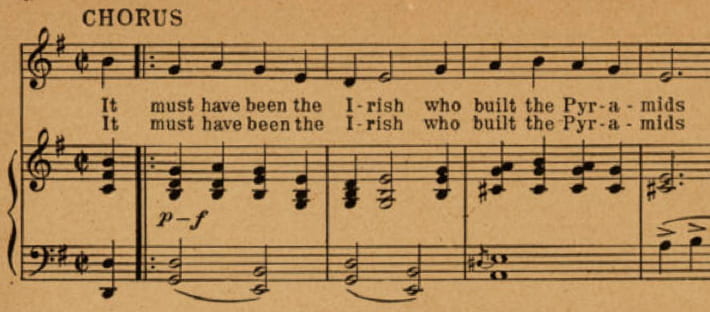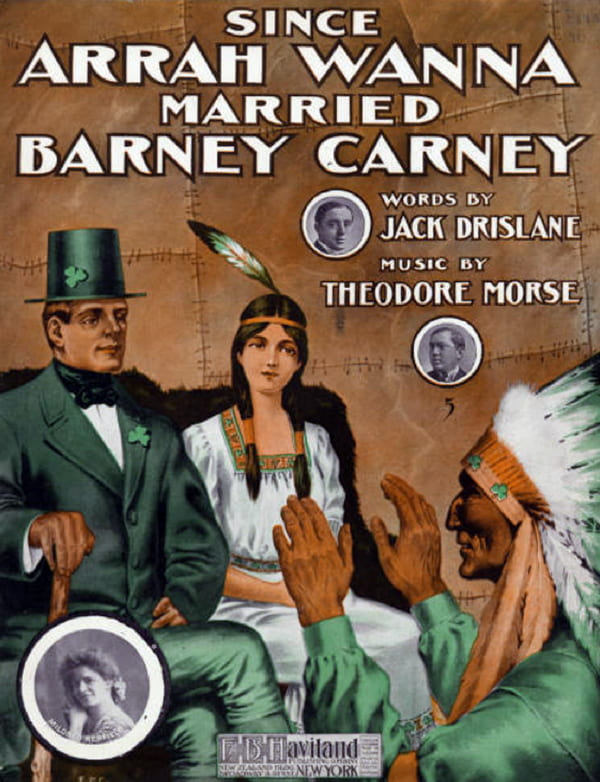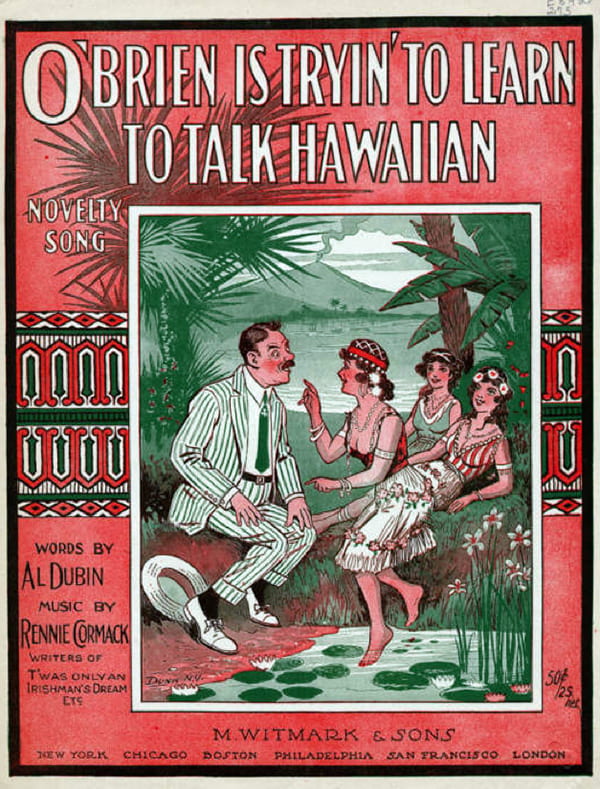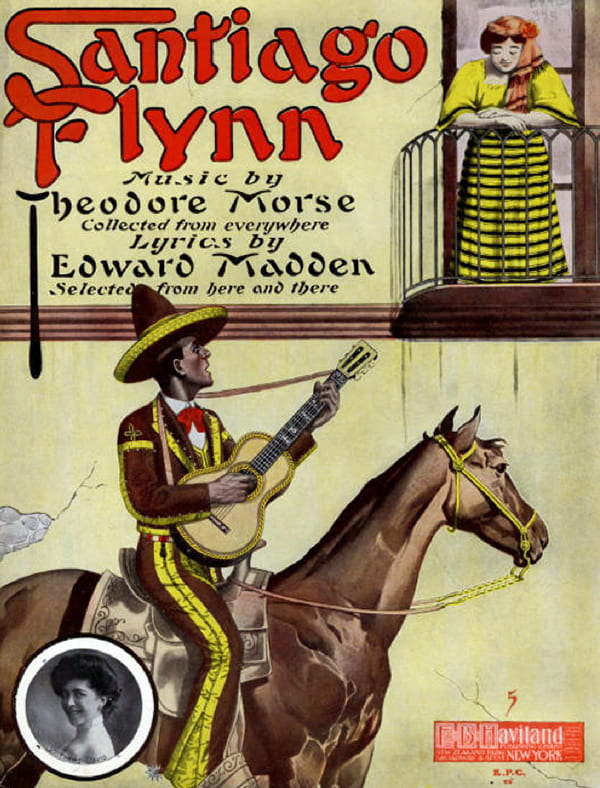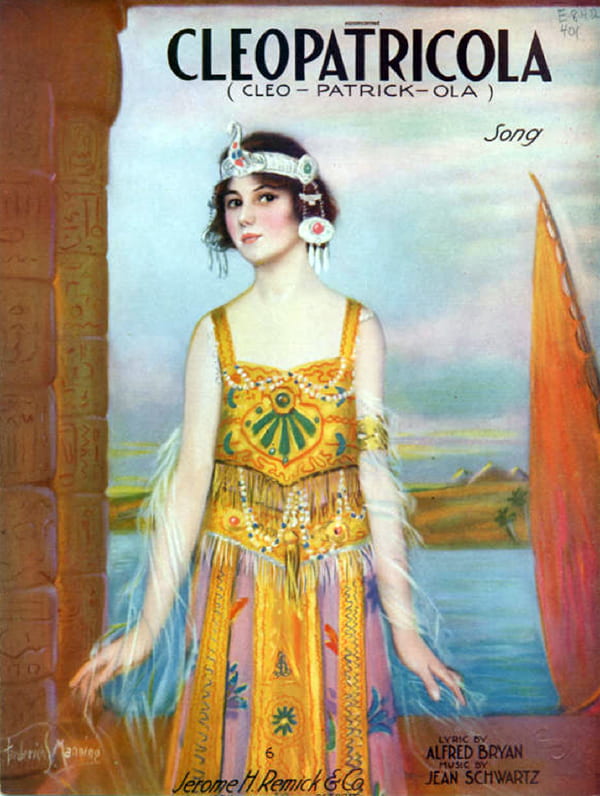As anyone with a pulse will recall, this past week saw the annual celebration of all things Irish: St. Patrick’s Day. And like any culturally specific holiday, it was a rousing blend of traditional folklore, modern contrivance (everyone should drink green beer, just like the Real Irish People Do!) and a smattering of stereotyping. And while modern society has, for the most part, toned down its outright offensive tendencies on days like St. Paddy’s (or Patty’s – there’s actually an ongoing argument online about that one), it wasn’t that far back in our history that the very real plight of Irish Americans was portrayed in popular culture in a starkly different way.
While browsing our Frances G. Spencer Collection of American Popular Sheet Music earlier this week in pursuit of some new material for our Tumblr, Digitized and Randomized, I went straight to a set of results based on Mrs. Spencer’s category, “Ethnic-Irish.” I got more than 300 results, and they ran the gamut from patently offensive to heartbreaking and everything in between. And so I thought it would be fun to examine some of the more unusual pieces of music from the Irish category, especially those that feature Irish protagonists in strange situations.
How Did We Get Here?
Before we jump into our results, it’s worth a quick peek into the history of Irish Americans prior to the mid-1900s (the time when the pieces we’ll examine were all created). In the late 1800s, Irish immigration to America had seen hundreds of thousands of men, women and children arriving in the U.S. and swelling the ranks of established Irish neighborhoods in East Coast cities as well as strongholds in the South. As the poorest of all immigrant groups to arrive in the U.S. in the 19th century, they often took dangerous, low-paying jobs. Add to this fact a tendency for urban neighborhoods to be crowded, unsafe and unsanitary, and you began to see a rise in alcohol abuse and crime – two stereotypical traits assigned to Irish Americans in the popular culture of the day (as we’ll see below).
Other sources of “inspiration” for the pieces we’ll explore today include the long-standing (and often violent) split between Irish Catholics and Irish Protestants; the alleged belligerence and/or violent tendencies of Irish men; the supposed moral and intellectual inferiority of the Irish; and the pervasive myth that the Irish are perpetually inebriated. As composers of the early 20th century set pen to paper in the pursuit of filling the American public’s insatiable appetite for musical entertainment, they kept these “facts” and half-truths about Irish Americans in mind, spawning pieces that drew on Irish Americans’ fond remembrances of their native culture (example) to anti-Irish sentiment (example).
An Irish Pharoah?
But understanding pro- and anti-Irish sentiment is a relatively easy task compared to puzzling out the meanings behind our featured pieces for this week’s post. They are loosely gathered around a pair of themes: the Irish protagonist in an unfamiliar setting and/or the presence of Irish where audiences wouldn’t expect to find it, like our first piece: The Irish Were Egyptians Long Ago.
The visuals on this piece are particularly striking, with a typical desert scene set before the pyramids mixed with the cognitive dissonance of a repeated shamrock motif on the throne of an Egyptian queen. The central conceit for this piece is that the narrator has deciphered a startling fact from the “weird and cryptic” writings found “upon the tombs that dot Sahara’s sands”: the Irish were Egyptians long ago – “Just read between the lines and you will know.”
The “proof” of their ancient Egyptian heritage is given as the fact that the pyramids were built by manual labor (“It must have been the Irish who build the Pyramids / For no one else could carry up the bricks”); the Nile was dug by a tough, brave man (“For no one but an Irishman would fight a crocodile”); and the drovers of desert caravans had to have been named Houlihan, Mac or O.
This piece achieves a strange blend of whimsy (adding shamrocks to a typical Egyptian scene) and humor with negative stereotyping of not one but two cultures. This two-front offensive is also evident in our next piece, Since Arrah Wanna Married Barney Carney.
Another “humorous” piece that trades on the unexpected mashup of two traditionally oppressed and/or caricatured cultures, this piece details the chaos that naturally followed when an Indian princess (Arrah Wanna) marries an Irishman named Barney Carney. It seems all it took to completely disrupt Native American culture (at least as the stereotypes would have it) was for one woman to marry a man from Erin, as evidenced by such strange occurrences as:
– “[n]o more do the Indians put paint upon their face”
– “The tom-toms play the ‘Wearing of the Green'”
– “The wigwams are full of Irish Blarney”
– “The Pipe of Peace is made of Irish clay”
There are more, but you get the picture. The introduction of an outsider of Irish origin upsetting the local culture (or attempting to assimilate into it in unexpected, humorous ways) will be repeated in our remaining pieces, each with the theme of romantic interest as a primary motivator. Up next is our final example of an Irishman falling under the guile of a “foreign” culture: O’Brien is Tryin’ To Learn To Talk Hawaiian.
Here, a hapless tourist from Ireland arrives in the Sandwich Isles (the name given to the Hawaiian Islands by Capt. Cook in the 1700s) and discovers the native women to be of such beauty that he instantly forgets his wife at home in the presence of a “lovely Hula dancer down beside Hawaii Bay.” Pat O’Brien, our protagonist, is revealed to be a skilled performer in his own right (“He won Bridget, Kate and Mary by singing ‘Tipperary’ / And he’ll win his Lulu too”) who is so moved by the girls’ beauty that he attempts to learn her native tongue, to hilarious results. In addition to being a standard “man falls in love with beguiling, exotic beauty” tale, there’s also the opportunity for lyricist Al Dubin to mock the languages of both Ireland and Hawaii, as in this tongue-twisting passage:
He’s sighin’ and cryin’ and all the time he’s tryin’
Just to say “I love you true”
With his “Arrah Yaka Hula Begorra Hick Dula”
And his Irish “Jiji Boo”
We never learn if this would-be suitor succeeds in his philandering pursuits, but we’ll leave him at his studies (“Hawaiian’s hard to get with an Irish alphabet”) and shift our attention to two pieces where the object of the narrator’s affection is a woman of Irish heritage. The first is set in the Rio Grande Valley of Texas and bears the title Santiago Flynn.
This piece relates a tale of two would-be lovers: Santiago Flynn (“He dressed like a Spanish grandee / He rode on a pony thin”) and an Irish Rose who lived on a nearby plantation. Though Rose liked the cut of Santiago’s jib (“She cried, ‘You’re a hot tamale'”), she regrets that she can only marry a man from Ireland. And then, to our surprise (SPOILER ALERT!), Santiago reveals his secret:
“He jumped in a wild fandango
He cried with an Irish grin
‘Tho born underneath the Mano
My father was Paddy Flynn’
And so was Santiago able to gain access to his lover’s abode (“She cried ‘Come in, Mister Flynn / I’ll never say again'”) and all ends well for our protagonist. It should be noted that this piece uses a particularly unpleasant slur used in reference to Santiago’s outward appearance, so be ready if you click over to read the lyrics in full.
Our last piece combines the exotic (an Egyptian setting) with the romantic, the stereotypical and the allure of an Irish woman’s beauty, all under a ridiculous title: Cleopatricola.
This piece comes closest to embodying all of the elements we’ve discussed so far into one semi-coherent package. Rather than post excerpts of the lyrics, I’m choosing to reproduce them in full:
VERSE
Once I took a camel ride
Far across the desert wide
Met a maiden way down by the Nile
As I sat down by her side
Her entrancing form I spiedThen she gave me a sweet Irish smile
She told me that she was born in Erin
Cleopatricola was her name
Mighty soon my love I was declarin’
I spoke these words and set her heart aflameCHORUS
Cleopatricola Cleopatricola
tell me what to do
By my heart and soul O Cleopatricola
I’m in love with youThere I found my Shamrock in Sahara
By the River Nile so fresh and green
Cleopatricola Patricola,
My Egyptian ColleenVERSE
As the sun was going down
We went down to Cairo town
Met King Pharaoh and all of his crew
First we read the Rubaiyat
Then we had a little chat
Played Casino with Pharoah till twoShe told me that she was “jipt” in Egypt
And that King Rameses was the blame
He told her she’d be a queen of Sheba
And spoke those very words before I came
(Repeat CHORUS)
This one’s got it all: a fish-out-of-water, a besotted suitor, a jilted lover, Irish motifs (the shamrock), local flair (Casino and the Rubaiyat) and Irish slang (referring to Irish women as Colleens). Add that to what I consider the best example of cover art of the pieces we’ve examined today – she looks like an Egyptian princess by way of Zelda Fitzgerald – and you have a winner in the category of Wait, Did I Seriously Just Read A Song About An Irish Person Doing WHAT?
I hope you’ve enjoyed this lighthearted look at some of the stranger pieces from our Irish subcategory in the Spencer Collection. There are no end of interesting pieces in the Spencer Collection, and we’ll be taking a look at them again from time to time. ‘Til then, if you find any fun examples of cross-cultural curiosity, send us a tip at digitalcollectionsinfo@baylor.edu. See you next week!
For more examples of Irish-themed sheet music in the Spencer Collection, click here. Special thanks to our friends at the Crouch Fine Arts Library for the partnership that brings the Spencer Collection to you via the Baylor University Libraries Digital Collections!

